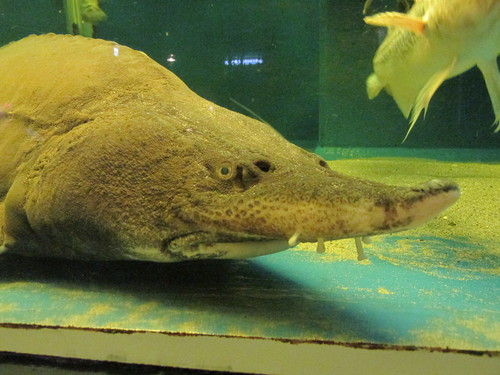
Kaluga sturgeon
The Atlantic bluefin tuna (Thunnus thynnus) is a majestic and highly migratory species of tuna found in the Atlantic Ocean. Renowned for its size, speed, and commercial value, it plays a crucial role in the marine ecosystem. This impressive fish faces significant conservation challenges.
55 80 years
Lifespan
560 cm
Length
Critically Endangered
Conservation Status
null km/h
Swimming speed
Carnivorous
Diet
Local Migration
Migration
Appearance Overview
The Atlantic bluefin tuna is renowned for its large, streamlined body, built for speed and endurance.
Color
Dark metallic blue above, silvery white below
Body shape
Torpedo-shaped, fusiform body
Fins
Two dorsal fins, the first retractable; small finlets behind second dorsal and anal fins
Keel
Strong lateral keel on the caudal peduncle
Length
Up to 13 feet (4 meters), commonly 6.5 feet (2 meters)
Weight
Up to 2,000 lbs (900 kg), commonly 550 lbs (250 kg)
Diet
Carnivorous, feeding on a variety of fish (like mackerel, herring, and bluefish), squid, crustaceans, and eels.
Feeding Behavior
Opportunistic and voracious predators, they use their speed and agility to hunt. They often hunt cooperatively, herding prey into tight groups.
Social Behavior
Highly migratory, forming large schools, especially during spawning season. Schools are often age-specific.
Commercial Relevance
Extremely high value, particularly in the sushi and sashimi market, where premium cuts can fetch extraordinary prices.
Conservation measures
Subject to strict international fishing quotas, catch documentation schemes, and minimum size limits. Marine Protected Areas (MPAs) also play a role.
Status
Endangered (IUCN)
Threats
Historical overfishing (severely depleted populations), continued fishing pressure, bycatch in other fisheries, and climate change affecting prey distribution.
Habitat Distribution
Depth Range
Surface waters to depths of over 3,000 feet (1,000 meters), though they typically stay in the upper water column.
Geographic Range
Western and Eastern Atlantic Ocean, Mediterranean Sea. Historically abundant, now found in reduced numbers.
Preferred Environment
Temperate and subtropical waters; pelagic, preferring open ocean but also found in coastal areas.
Reproduction and Life Cycle
Breeding Habits
Spawns in warm waters, primarily in the Mediterranean Sea and the Gulf of Mexico, during specific seasons (spring/summer).
Development Stages
Eggs hatch into larvae, which are planktonic. Juveniles grow rapidly, undergoing significant physiological changes as they mature.
Fecundity
Highly fecund; a large female can release up to 30 million eggs per spawning season.
Maturity Age
Reaches sexual maturity relatively late, around 4-8 years in the Western Atlantic and earlier in the Eastern Atlantic.
Faqs about Kaluga sturgeon
How fast can Atlantic bluefin tuna swim?
Atlantic bluefin tuna are among the fastest fish in the ocean, capable of short bursts of speed up to 40-60 mph.
How long do Atlantic bluefin tuna live?
They can live up to 40 years, although this is less common now due to fishing pressure.
Are Atlantic bluefin tuna warm-blooded?
Yes, they are warm-blooded, unlike most fish. They have a specialized circulatory system that allows them to maintain a body temperature higher than the surrounding water.
What's the largest Atlantic bluefin tuna ever caught?
The record is over 1,496 pounds (679 kg), caught off Nova Scotia in 1979.
How far do Atlantic bluefin tuna migrate?
They undertake extensive migrations across the Atlantic Ocean, traveling thousands of miles for feeding and spawning.
Where do Atlantic Bluefin Tuna Spawn?
The main spawning grounds are in the Mediterranean Sea and the Gulf of Mexico.
Copyright @ Nature Style Limited. All Rights Reserved.
 English
English